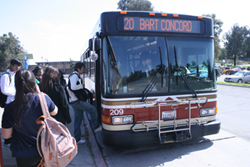DVC student Mariam Akbar, 36, relies entirely on the bus to get to school, work, church and other appointments. But a 25-cent fare increase and changes in routes and operating hours make it harder to get around.
“For the bus to be so late, and fares to go up,” she said, “it does not make any sense.”
English major Ian French, 22, is also frustrated.
“I have to wake up a half hour earlier to get to school at the same time [as before the cuts],” he said.
Effective March 22, the Contra Costa Transit Authority slashed service routes and raised fares in an effort to cut $4 million from its current $29.3 million budget.
Mary Burdick, CCTA’s public relations spokeswoman, blamed the changes on several years of cutbacks in state funds, the loss of gas sales tax revenues in February and the high cost of fuel.
Previously, the transit company dipped into its reserve to maintain its current level of service, but the reserve is gone, Burdick said.
“If we didn’t act…this year, we would not have been able to make payroll,” she said.
In addition to eliminating bus service in some areas and increasing fares, old routes were reconfigured, and the new routes were then given new numbers, based on data showing which routes were most frequently used, Burdick said.
CCCTA also eliminated the free mid-day fare program for seniors and riders with disabilities, although transfers were extended to two hours instead of one. In addition, it laid off 28 bus drivers.
Once the service cuts were final, CCCTA posted flyers inside of buses, placed newspaper ads, taped new transit maps onto bus shelters, mailed out newsletters to about 170,000 residences within the service area and posted a notice on its website, Burdick said. Transit company representatives also came to DVC in early March for the same purpose.
Still, some DVC students said they were caught off guard.
Data gathered since the first day of the new service shows overall ridership has dropped by 17 percent. But considering that 23 percent of service was cut, it is not a bad sign, Burdick said.
At DVC, ridership even slightly increased. In winter 2008, an average of 539 students boarded buses each day, compared to 547 during the first week of the new service, Burdick said.
But Ronette Brown, a County Connection bus driver for the past 19 years, said crowded buses and less frequent service – both products of the cuts – are an inconvenience to riders.
“I feel we’ve put [bus] service back in time,” she said.
Ann Muzzini, CCCTA’s director of planning, said the new routes provide better links between destination frequented by students, such as route 9, which now connects Pleasant Hill BART with downtown Pleasant Hill and Walnut Creek.
But she admitted there are problems. “You can’t cut 23 percent of service and not have a negative effect,” Muzzini said.
If students are unhappy, Muzzini said CCCTA would welcome the feedback, especially since revisions will be discussed on June 16. To voice an opinion, log onto cccta.org and click “contact us.”
DVC student Linda Wolf, 21, is one such unhappy rider. She said the bus no longer goes past her house, so she must either walk to a bus stop 20 minutes away or ask her mother for a ride.
“I avoid the bus at all costs,” Wolf said. “Now, I’m so anxious when I’m on the bus and have to get to school by a certain time. It takes forever.”





































































